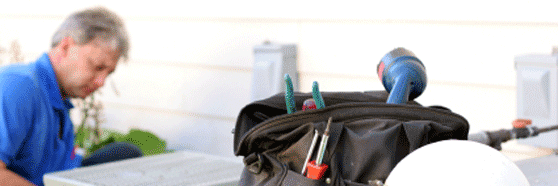|
ComfortPlus© Maintenance |
|
 ComfortPlus© Maintenance - Each
ComfortPlus© comes with a manufacturer recommended maintenance. Ryan shall provide the labor and components to perform the following building system Preventive Maintenance:
ComfortPlus© Maintenance - Each
ComfortPlus© comes with a manufacturer recommended maintenance. Ryan shall provide the labor and components to perform the following building system Preventive Maintenance:
Electrical Systems
- Check circuit operation.
- Test GFI circuits.
- Test AFCI circuits.
- Check grounding & bonding.
- Examine exposed wiring.
- Perform infrared temperature examination.
- Tighten panel main lugs.
- Tighten panel connections.
- Check systems for water, rust or corrosion.
- Check panel labeling.
- Clean exterior of equipment.
- Clean up work area.
- Examine system for code compliance.
- Make safety & conservation recommendations.
- Certify maintenance if required.
- Apply service stickers.
Plumbing Systems
- Test water pressure.
- Make water conservation recommendations.
- Perform water quality test (ph, hardness, iron, manganese, chlorine and tdc).
- Visually inspect for signs of Iron Bacteria or Sulfur Bacteria.
- Check exposed supply piping for leaks.
- Test toilet operation.
- Test for toilet leaks.
- Perform whole house water leak test.
- Test faucet performance.
- Check grout around shower and bath.
- Tighten packing nuts if necessary.
- Check for slow drains.
- Make Bio-Clean recommendations.
- Check exposed DWV piping for proper pitch.
- Check exposed DWV piping for leaks.
- Prime floor drains.
- Check hot water temperature.
- Test main valve.
- Check outdoor faucets. Provide draining instructions. Recommend frost free.
- Check for potential areas of freezing.
- Clean up work area.
- Examine system for code compliance.
- Examine water bill for accuracy (upon request).
- Check water meter accuracy.
- Certify maintenance if required.
- Clean up work area.
- Apply service stickers.
Heating Systems
- Check and clean thermostats.
- Replace standard batteries in thermostat.
- Check system operation.
- Adjust system to maximum efficiency.
- Check & clean flue pipe.
- Clean chimney base.
- Check chimney draft.
- Check heat exchanger integrity.
- Clean heat exchanger.
- Check burners; clean.
- Check & clean combustion air intake.
- Check & adjust ignition electrodes.
- Check high tension buss wires for shorts.
- Check & tighten wiring at unit.
- Check voltage.
- Check control transformer for proper voltage.
- Check safety controls.
- Check limit controls.
- Gas: Complete safety check per IFGC / 2006 Appendix D Specifications.
- Gas: Check gas valve.
- Gas: Replace thermocouple if necessary.
- Gas: Check & clean pilot burner.
- Gas: Check pilot height for proper ignition.
- Gas: Check & clean pilot crossovers.
- Gas: Check flame & flue rollout safety switch.
- Gas: Check & lubricate draft inducer motor.
- Gas: Check & clear condensate line.
- Oil: Check & clean chamber.
- Oil: Clean oil filter bowl; replace filter & gasket.
- Oil: Clean nozzle assembly.
- Oil: Replace nozzle.
- Oil: Check burner end cone.
- Oil: Clean fuel pump; replace pump strainer & gasket.
- Oil: Check fuel pump cut-off & seal.
- Oil: Check indoor oil tank.
- Oil: Check accessible oil lines & fittings for leaks.
- Oil: Check & clean flame sensor.
- Oil: Lubricate burner motor.
- Oil: Check amperage of burner motor.
- Oil: Check ignition transformer for proper voltage.
- Oil: Clean oil burner housing.
- Air: Change dampers to seasonal position.
- Air: Check wear, tension & alignment of blower belt: adjust or replace.
- Air: Check & lubricate blower bearings.
- Air: Lubricate blower motors.
- Air: Check and clean blower wheel.
- Air: Check blower motor amperage.
- Air: Clean or replace normal air filters.
- Air: Replace media filters.
- Air: Clean electronic air cleaner cells & pre-filter.
- Air: Clean humidifier; replace panel.
- Air: Clean UV light bulb; replace bulb as needed.
- Water: Check pressure reducing valve.
- Water: Check pressure relief valve.
- Water: Check & lubricate circulators.
- Water: Check & drain expansion tank.
- Water: Check zone valves.
- Steam: Clean or replace gauge glass.
- Steam: Install new gauge glass washers.
- Steam: Install new gauge glass washers.
- Steam: Clean pressuretroll pigtail.
- Steam: Drain & check low-water cutoff.
- Clean exterior of equipment.
- Clean up work area.
- Examine system for code compliance.
- Make safety & conservation recommendations.
- Certify maintenance if required.
- Apply service stickers.
Cooling Systems
- Check and clean thermostats.
- Replace standard batteries in thermostat.
- Check system operation.
- Adjust system to maximum efficiency.
- Lubricate condenser motors.
- Check & tighten wiring at unit.
- Check voltage.
- Check capacitors.
- Check amperage of condenser motors.
- Check relay for decayed contacts.
- Check crankcase heater operation.
- Check crankcase oil level.
- Check oil protection safety control.
- Check refrigerant pressure safeties.
- Check condenser coil. Clean if necessary.
- Check refrigerant operating pressures.
- Check air temperature across condenser.
- Check air temperature across evaporator.
- Check & clear condensate line.
- Add cooling tower water treatment.
- Winterize cooling towers.
- Change dampers to seasonal position.
- Check wear, tension & alignment of blower belt: adjust or replace.
- Check & lubricate blower bearings.
- Lubricate blower motors.
- Check and clean blower wheel.
- Check blower motor amperage.
- Clean or replace normal air filters.
- Replace media filters.
- Clean electronic air cleaner cells & pre-filter.
- Clean humidifier; replace panel.
- Clean UV light bulb; replace bulb as needed.
- Clean exterior of equipment.
- Clean up work area.
- Examine system for code compliance.
- Make safety & conservation recommendations.
- Certify maintenance if required.
- Apply service stickers.
Exhaust Systems
- Check & clean bird screen.
- Lubricate fan & motor bearings.
- Check control operation.
- Check belts: adjust or replace.
- Examine smoke detectors.
- Examine carbon monoxide detectors.
- Clean exterior of equipment.
- Clean up work area.
- Examine system for code compliance.
- Make safety & conservation recommendations.
- Certify maintenance if required.
- Apply service stickers.
Electric Generators
- Inspect fuel lines and connections.
- Check fuel levels
- Check belts.
- Check coolant concentration if applicable.
- Check cooling system.
- Change engine oil.
- Change engine oil filter.
- Change fuel filter if applicable.
- Inspect and clean enclosure and louvers.
- Inspect and clean battery.
- Inspect and tighten battery terminals.
- Inspect crankcase heater.
- Inspect exhaust system.
- Inspect safety devices.
- Inspect brushes and slip rings if applicable.
- Check battery charge state.
- Check battery electrolyte levels (unsealed only).
- Lubricate engine linkage parts and brackets.
- Check adjust valve clearances if required.
- Change air cleaner.
- Change spark plugs.
- Check transfer switch operation.
- Check voltage and frequency.
- Check general condition (vibration, noise, leakage, temperature).
- Clean exterior of equipment.
- Clean up work area.
- Examine system for code compliance.
- Maintain EPA Required Records
- Make safety conservation recommendations.
- Certify maintenance if required.
- Apply service stickers.
Solar Photovoltaic
- Continuous monitoring of system if applicable.
- Check wiring connections.
- Inspect & maintain combiner box.
- Inspect overcurrent protection devices.
- Measure voltage and amperage of system.
- Check circuit operation.
- Check grounding & bonding.
- Examine exposed wiring.
- Perform infrared temperature examination.
- Tighten panel main lugs.
- Tighten panel connections.
- Check systems for water, rust or corrosion.
- Clean exterior of equipment.
- Clean panels if production drops below 82% potential (Enhanced).
- Remove snow within 48 hours of snowfall (Enhanced).
- Clean up work area.
- Check equipment labeling.
- Apply service stickers.
- Examine system for code compliance.
- Make safety & conservation recommendations.
- Certify maintenance if required.
Alarm Systems
- Clean and test smoke detectors.
- Check and test heat detectors.
- Inspect and test pull stations.
- Inspect and test horn/strobes.
- Multi-meter test all resistors in panel.
- Tightened lugs in panel.
- Test all circuits for ground faults.
- Identify and quote repairs for all system faults.
- Inspect and tighten battery terminals.
- Check battery charge state.
- Check voltage and frequency.
- Clean exterior of equipment.
- Clean up work area.
- Examine system for code compliance.
- Make safety recommendations.
- Certify maintenance if required.
- Apply service stickers.
Laundry Room
- Check appliance operation.
- Adjust systems to maximum efficiency.
- Check & clean dryer exhaust.
- Check gas dryer CO levels and report unsafe conditions.
- Clean lint screens.
- Check dryer burners; clean if necessary.
- Check & clean dryer combustion air intake.
- Check & adjust dryer ignition electrodes.
- Check high tension buss wires for shorts.
- Check appliance voltage.
- Check safety controls.
- Check limit controls.
- Check dryer gas valve.
- Check & clear washing machine drain.
- Check amperage of all motors.
- Check wear, tension & alignment of belts.
- Lubricate motors.
Kitchen
- Check appliance operation.
- Adjust systems to maximum efficiency.
- Check & clean refrigerator condenser coil.
- Check oven CO levels and report unsafe conditions.
- Check gas oven burners; clean if necessary.
- Check & adjust oven/range ignition electrodes.
- Check appliance voltage.
- Check safety controls.
- Check limit controls.
- Check oven/range gas valve(s).
- Check & clear dish washer drain.
- Check in-sink garbage disposal systems.
- Check amperage of all motors.
- Lubricate motors.
Water Treatment
- Check operation.
- Adjust systems to maximum efficiency.
- Supply and deliver softner salt.
- Change pre and post filters.
- Change RO Membrane (Every 24 Months).
- Replace Salt Free Conditioner where applicable (Every 60 Months).
- Replace Rhino Whole House Filter where applicable (Every 60 Months).
- Flush System.
At All Maintenances
- Examine smoke detectors.
- Examine carbon monoxide detectors.
|
|
|
Details |
|
Introduction - Imagine the comfort
& security of a systematic maintenance plan. |
|
Benefits - Click to learn about the many
important benefits of the Ryan ComfortPlus©.
|
|
Maintenance -
Find out about our comprehensive preventive maintenance visit. |
|
Terms - Read the ComfortPlus© Terms for its benefits
and limitations. |
|
Pricing - See how little it costs for the peace of mind a ComfortPlus© brings. |
|
Registration - Register online for
immediate ComfortPlus© coverage of your systems.
|
|

|
|
|
|